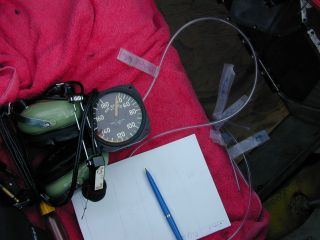Under Cowling Pressure Distribution
There is an ongoing discussion about the efficiency of the air cooling in our birds. Very often the gap between the airframe and the cowling is referred to as to create suction to the whole engine department or many other assumptions. To get me a better picture, I needed some data about the pressure distribution under the cowlings of our birds and came up with the following setup: I attached several thin hoses at various points under the cowling. The open ends act as pressure pickup points.
The pick-up points: 1. On the pressure side of the baffling above the cylinders - right side 2. Close to the oil filler cap, long neck oil sump - right side 3. Behind carburetor at the oil sump neck 4. Under the air filter box 5. At gap of cowling to airframe left side. Here are some pictures of the installation.



I routed my five hoses into the cabin, where an old airspeed meter is used to supply the data.

Since we are only interested in the pressure differences between the pick-up points, it does not matter that we read MPH instead of pound per square inch or kp/m2.
I flew in 3 different conditions for the test. Climb, cruise, descend.
Here are my readings:
| climb | cruise | descend | |
| Above cylinders | 100 | 130 | 90 |
| Oil filler cap | 85 | 110 | 75 |
| Behind Carb/at oil sump | 85 | 110 | 80 |
| Gap cowling | 60 | 95 | 75 |
At all spots I had positive pressure readings all the time. It shows that the whole cowling is pressurized in-flight. The gap at the cowling is the lowest pressure point,as expected, but by no means is there negative pressure.
Generally can be said that all three spots below the cylinder baffles showed similar readings. The differences are due to the fact that I had only one instrument and had to swap out the hoses while trying to keep the experiments condition stable. But the trend shows similar data.
Conclusion: The cowling of our birds is charged with air in flight. The highest pressure above the cylinders, the lowest at cowling gap, where the air exits. The rest under the cylinders is under a similar high pressure.
Cooling of the whole engine is done because air is pushed through the compartment, not because it is sucked out of it. The baffling around the engine is important to secure an even cooling flow around the cylinders, nothing more or less.
| << previous |